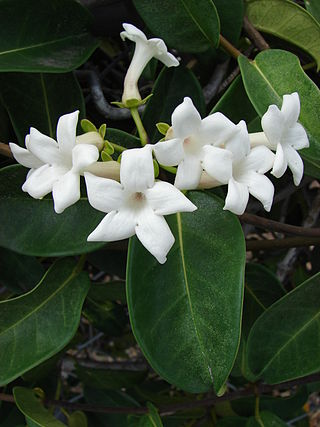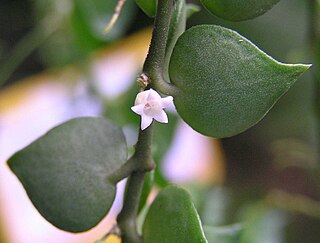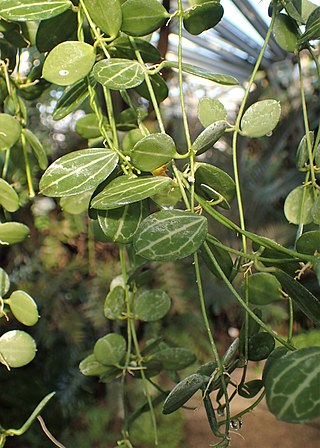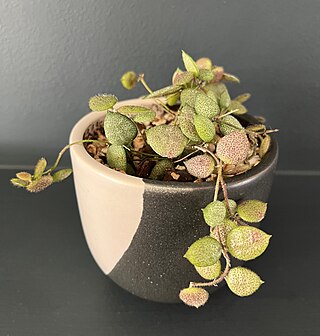
Agricultural science is a broad multidisciplinary field of biology that encompasses the parts of exact, natural, economic and social sciences that are used in the practice and understanding of agriculture. Professionals of the agricultural science are called agricultural scientists or agriculturists.

An epiphyte is a plant or plant-like organism that grows on the surface of another plant and derives its moisture and nutrients from the air, rain, water or from debris accumulating around it. The plants on which epiphytes grow are called phorophytes. Epiphytes take part in nutrient cycles and add to both the diversity and biomass of the ecosystem in which they occur, like any other organism. They are an important source of food for many species. Typically, the older parts of a plant will have more epiphytes growing on them. Epiphytes differ from parasites in that they grow on other plants for physical support and do not necessarily affect the host negatively. An organism that grows on another organism that is not a plant may be called an epibiont. Epiphytes are usually found in the temperate zone or in the tropics. Epiphyte species make good houseplants due to their minimal water and soil requirements. Epiphytes provide a rich and diverse habitat for other organisms including animals, fungi, bacteria, and myxomycetes.

The Asclepiadoideae are a subfamily of plants in the family Apocynaceae. Formerly, they were treated as a separate family under the name Asclepiadaceae, e.g. by APG II, and known as the milkweed family.

The Hortus botanicus of Leiden is the oldest botanical garden of the Netherlands, and one of the oldest in the world. It is located in the southwestern part of the historical centre of the city, between the Academy building and the old Leiden Observatory building.

Uvularia sessilifolia, the sessile bellwort, sessileleaf bellwort, little merrybells or wild oats, is a species of bellwort native to eastern and central North America. It grows in woodlands with wet or dry soils.
Dischidia is a genus of plants in the “dog-bane” family Apocynaceae, collectively known as the “milkweeds”. They are epiphytes, native to tropical areas of China, India as well as Bhutan’s southern borders, wherever minimal frost occurs. Additionally, they are known from most areas of Mainland Southeast Asia, including forested areas of Myanmar, Thailand, Vietnam, Cambodia, Laos, and some parts of Indonesia, Malaysia and Singapore. Several species are also native to Papua New Guinea and northeastern Australia.

Marsdenia is a genus of plants in the family Apocynaceae first described as a genus in 1810. It is named in honor of the plant collector and Secretary of the Admiralty, William Marsden. The plants are native to tropical regions in Asia, Africa, Australia, and the Americas.
Dischidia diphylla was described by Adolph Daniel Edward Elmer but never validly published since Elmer failed to include Latin diagnoses or descriptions for the species he described after 1934.

The 1978 Massachusetts gubernatorial election was held on November 7, 1978. Former Massachusetts Port Authority executive director Edward J. King was elected to a four-year term, from January 4, 1979, until January 6, 1983. King won the Democratic nomination by defeating incumbent Governor of Massachusetts Michael Dukakis in the Democratic primary.

Dischidia major, the Malayan urn vine, is a plant in the genus Dischidia. They carry modified leaves, offering accommodation to ants, including those of the family Dolichoderinae, and in return gain some sustenance from increased carbon dioxide and nitrogen levels, and a degree of protection from noxious animals and plants. This mutualism trait, known as myrmecophily, is widespread across the plant world and clearly carries considerable benefits for both ants and plant.

Dischidia ruscifolia, also known as million hearts, is an epiphytic plant native to the Philippines.

Dischidia nummularia is an epiphytic climbing plant that belongs to the genus Dischidia. It has tiny, opposite lens-shaped leaves, and is frequently seen on the trunks of trees. In the wild it is found in India, China, Indonesia, Laos, Thailand, Vietnam, Myanmar, Malaysia, and Australia.
Dischidia tonkinensis is an epiphytic plant in the genus Dischidia. It is distributed mainly in the south China provinces of Yunnan, Guangxi, and Guizhou, at altitudes of 300 to 1,200 m above sea level. It normally grows in mountain forests and on rocks. Dischidia esquirolii is a synonym. It has not been cultivated.
Danilo Tandang is a Filipino botanist, working in the National Museum of the Philippines, Philippines

Dischidia ovata, commonly called watermelon dischidia, is a small vine in the frangipani and hoya family Apocynaceae, native to New Guinea and Cape York Peninsula, Australia. The species name ovata refers to its ovate leaves, its common name refers to the leaf venation that resembles a watermelon rind. The species is succulent and grows as an epiphytic or lithophytic vine in a variety of habitats.

Dischidia vidalii, commonly known as an "ant plant" or "kangaroo pouch", is a plant in the genus Dischidia native to the Philippines. D. vidalii is an epiphytic climbing plant with clusters of pink or magenta flowers. Like some others in its genus like Dischidia major and in the related genus Hoya, this species has evolved a symbiotic relationship with ants. In addition to small, oval leaves the plant develops significantly larger, hollow leaves where additional roots grow and there is habitat for ants where water and debris collect that nourish the roots.

Dischidia imbricata is a plant in the genus Dischidia native to Southeast Asia from Vietnam to Borneo and Java. Like Hoya imbricata, Dischidia imbricata is a shingling plant that, as it grows epiphytically, clings closely to the host plant and may even have leaves that are completely flat like roof shingles.

Dischidia platyphylla is a species of plant in the genus Dischidia native to the Philippines. Its name (platyphylla) refers to the flattened leaves, which as it climbs may cling in a shingle-like way to trees, similar to related species like Dischidia imbricata. These leaves are a form of domatia, which act as a shelter for ants in an example of mutualism with ants that is found in several species of Dischidia.

Dischidia hirsuta is a species of plant in the genus Dischidia. It is widely distributed in Southeast Asia from Thailand through Vietnam, Indonesia, the Philippines and continuing to the Solomon Islands. It grows as an epiphyte and its name refers to its often hirsute foliage covered in fine hairs, though the species has variable foliage and flowers throughout its range. Its succulent leaves may be lanceolate to more rounded, and are sometimes covered with red spots. The flowers range from pale yellow to dark red.

Dischidia astephana is a species of plant in the genus Dischidia native to Peninsular Malaysia and Borneo. A vining epiphyte that can cover an entire tree branch in dense leaves, it is often found growing near other Dischidia including D. albida,D. parvifolia, and D. vadosa. Its leaves are shaped like flat rings or domes, some of which will be tightly appressed to the surface of the tree where it grows. It lives symbiotically with ants of the Crematogaster genus on trees, with the roots growing inside ant nests and using debris for nutrients.
















